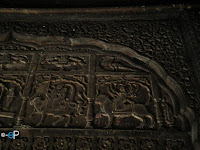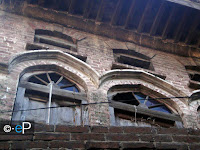eP.explorePakistan
Directorial venture, eP -explorePakistan is country’s first social-media project in which culture and heritage are documented from the perspective of a traveler. In 2007 right after Facebook was launched, to share my personal photograph-based travel stories to significant yet less discovered spots in Pakistan. I document city heritage, timeworn architectural and cultural objects, people in their original environs, and often times beautiful frames that only an artist can see. Zaheer Chaudhry
Monday, May 26, 2025
Rattu to Shounter
Sunday, December 10, 2023
Eminabad
Eminabad: A Tapestry of Heritage, History, and
Cultural Resilience
Photo courtesy Zaheer Chaudhry
Introduction: Eminabad stands as a testament to the cultural and historical legacy of Pakistan, nestled along the Grand Trunk Road in Punjab. This article aims to unravel the layers of Eminabad's history, shedding light on its architectural treasures, religious landmarks, and the cultural mosaic that defines its identity.
Historical Background: Before the partition, Eminabad was a melting pot of religious diversity, with Muslims, Hindus, and Sikhs coexisting harmoniously. The mass migration that accompanied the birth of Pakistan led to the departure of Hindu and Sikh communities to India, leaving behind their shrines and traces of a shared past.
Architectural Marvels: Eminabad is adorned with historical buildings that stand as silent witnesses to bygone eras. Kali Kothi, a structure built by Kartar Nath Manchandain in 1932, showcases the architectural splendor of the town. Among these treasures, the Dewan Hawali emerges as the most striking piece of historical architecture, reflecting the craftsmanship of its time.
Religious Landmarks: The town is home to three historical shrines, Shive Mandars, and Gurdwara Nanak Sahib, emphasizing the once vibrant tapestry of religious diversity. Guru Nanak, the founder of Sikhi, is said to have stayed at Eminabad, leaving an indelible mark on the cultural and religious landscape. The Gurdwara built over this significant site is a testament to the enduring legacy of Sikh history.
Cultural Traditions: Eminabad's cultural vibrancy is manifested in its love for kite flying, a tradition associated with the Basant festival that was once an integral part of every Eid celebration. The ban on kite flying by the Pakistani government, driven by valid reasons, has altered the cultural landscape but has not dampened the spirit of the people.
Contemporary Scenario: The research also sheds light on the present-day scenario, acknowledging the efforts of the Pakistani government in preserving cultural heritage. The construction of a new Gurdwara building at the cost of PKR 20 million reflects the commitment to safeguarding historical landmarks, with the Sikh community actively participating in its maintenance.
Acknowledgments: The research expresses gratitude to the local community members who generously shared their time and insights. Special thanks are extended to Sayed Arif Ali, Hafiz Ali, the last natives of Dewan Haweli, and Aqib, the neighbor of Kali Kothi, for their kindness and cooperation during the research.
Conclusion: Eminabad stands as more than a geographical location; it is a living testament to the confluence of diverse cultures, religions, and traditions. Through this research, we aim to foster a deeper understanding of Eminabad's historical significance, ensuring that its heritage continues to resonate through the corridors of time.
The Legends of Peshawar Kapoor's Haveli
Preserving History: Kapoor Haveli's Journey from Home to Heritage
In the heart of Peshawar, Pakistan, stands a silent witness
to the golden era of Indian cinema and the illustrious Kapoor family – the
Kapoor Haveli. This residential building, constructed between 1918 and 1922 by
Dewan Basheswarnath Kapoor, is more than just brick and mortar; it is a
repository of memories, a living testament to the Kapoor family's legacy in the
world of show business.
The Kapoors, proud Punjabi Hindus, called this haveli home,
and it was within these walls that the first seeds of cinematic stardom were
sown. Prithviraj Kapoor, the patriarch, paved the way for the family's entry
into the film industry in 1928. The likes of Trilok Kapoor, Prithviraj's
younger brother, and the legendary Raj Kapoor, were born within the confines of
this historical abode.
However, the echoes of history reverberate with the
partition of India in 1947. As with many other Hindu families, the Kapoors left
their city and their ancestral home. The haveli, once bustling with the
laughter and footsteps of a thriving family, fell into the hands of new owners
through an auction in 1968.
Fast forward to the present day, and Kapoor Haveli is in the
spotlight once again. IMGC Global Entertainment, in collaboration with the
Khyber Pakhtunkhwa government, is undertaking the noble task of transforming
this historic residence into a museum. The move not only pays homage to the
Kapoor family's contributions to the world of entertainment but also serves as
a testament to the cultural ties that transcend borders.
The journey to preserve Kapoor Haveli, however, is not
without its challenges. Valued at Rs 15 million in 2021, the deputy
commissioner of Peshawar has initiated plans to convert the building into a
museum, issuing notices to the current owner, Gul Rehman Mohmmad, who seeks Rs
2 billion in return.
The haveli's history is etched in every brick and wooden
slab. According to the inscription at the entrance, its construction commenced
in 1918, a period that witnessed the tail end of British India. Raj Kapoor, one
of Indian cinema's most iconic figures, took his first breaths within these
hallowed walls in 1924, while two younger siblings, born in 1931, also began
their journey here.
Over the years, the Kapoor Haveli faced the test of time,
including an earthquake that led to the demolition of its top three stories two
decades ago. Today, surrounded by commercial structures that pose a threat to
its structural integrity, the haveli stands as a symbol of resilience against
the forces of change.
In 1990, Raj Kapoor's younger brother, Shashi Kapoor, along
with his sons Randhir Kapoor and Rishi Kapoor, made a poignant visit to
Peshawar. Their pilgrimage to the family home, marked by taking soil from the
compound as a memento, showcased a poignant connection to their roots.
As the tale of Kapoor Haveli unfolds, it becomes more than a
story of a historic building; it becomes a narrative of shared heritage,
cultural ties, and the collective responsibility to preserve the treasures that
bind us to our past. The journey from a family home to a potential museum is a
step towards ensuring that the Kapoor legacy lives on for generations to come.
.
Rattu to Shounter
Rattu to Shounter Beginning at Thalichi Bridge on the Astore Road, the Shounter Road, also known as Rattu Road, unfolds like a living corr...

-
Rattu to Shounter Beginning at Thalichi Bridge on the Astore Road, the Shounter Road, also known as Rattu Road, unfolds like a living corr...
-
During British Raj, in 1930s came a change in the development of middle class localities in Lahore and areas like Krishan Nagar and Sant Nag...
-
Eminabad: A Tapestry of Heritage, History, and Cultural Resilience Photo courtesy Zaheer Chaudhry Abstract: Eminabad, a time-honored town s...
























































